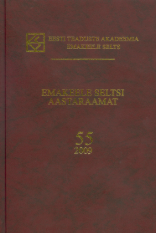KIRJAVIISIVAHETUS KIRIKURAAMATUTES
CHANGE OF SPELLING STYLE IN PARISH REGISTERS
Author(s): Fred PussSubject(s): Language studies, Modern Age, Recent History (1900 till today), Historical Linguistics, Finno-Ugrian studies
Published by: Teaduste Akadeemia Kirjastus
Keywords: Estonian language; language history; orthography; paleography; onomastics; language planning;
Summary/Abstract: Until the 1840s old spelling style prevailed in the Estonian language. In 1843 in his grammar Lutheran pastor Eduard Ahrens introduced a new spelling style which was inspired from the Finnish one. Spreading of new style was not rapid and in 1844 only four Lutheran pastors in North Estonia started to use it in their parish registers. In the 1850s only two more joined and in 1867 two first pastors from South Estonia accepted the new style. Lutheran pastors were almost entirely Baltic Germans until that time. In South Estonia the first pastors to accept the new style were sympathetic to the national awakening of Estonians, which was stronger there and weaker in North Estonia. Also first pastors of Estonian ethnicity appeared in the 1870s in South Estonia and most of them (but not all) started to keep their parish registers in new spelling style. By 1875 most of published books were already in new spelling style, but some clerical books still appeared in the old style. The New Testament was printed in the new style for the first time in 1888 and the whole bible in 1889. Of the 110 analysed congregations 76 accepted the new spelling style by 1891. Mostly it was done in the 1880s (47 congregations), peak years were 1880–1881. Of the pastors who changed the spelling style, 32 were new to the congregation, 17 had worked there from 2–7 years, 13 from 8–15 years and 11 from 16–36 years. The number of changing congregations was quite equal in North and South Estonia (also in absolute numbers). The highest percentage of congregations who accepted the new style was 100% in Viljandi county, 87% in Lääne county and 85% in Harju county. The smallest was 22% in Võru county, 43% in Järva county and 47% in Tartu county. In Võru and Tartu counties possibly the Southern dialect (“Tartu language”) was the factor of small style change ratio. Since 1892 parish registers were ordered to be kept in Russian/Cyrillic and not all pastors added names in Latin alphabet. Thus it is not possible to analyse the spelling change since 1892 in all of Estonia.
Journal: Emakeele Seltsi aastaraamat
- Issue Year: 2017
- Issue No: 63
- Page Range: 166-200
- Page Count: 35
- Language: Estonian

